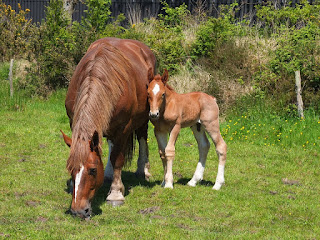The most natural method of breeding horses is when the stallion runs loose with the mares however nowadays there are three other main methods used:
Artificial insemination where semen is collected from the stallion and placed into the mare artificially
In-hand breeding, where stallion and mare are brought together in hand under controlled circumstances
Embryo transfer, when an embryo is taken from one mare and implanted into another who will carry it for the full term of the pregnancy
Allowing a stallion to run with his mares is the most traditional method and the horses are able to behave as they would in their natural wild state. However it is not a method that is widely practiced in commercial studs due to the management disadvantages. In this situation it is never possible to be certain which mares have been mated and on what dates. The risk of injury is also very high and such injuries can be difficult to spot or to treat as the stallions generally do not welcome human contact in their herd.
In hand breeding is the most commonly used method in commercial studs. The mare and the stallion are brought together and held by handlers. Mares are frequently placed in hobbles to avoid kicks and injuries to valuable stallions. This method allows for much greater management and veterinary intervention ensuring that the mare is at her peak time to conceive before presenting to the stallion and that due dates are known.
Artificial insemination has become a lot more common as it is making breeding with top stallions accessible to all. It also reduces the management of the mares as they can be inseminated at home or at their local vets rather than having to travel to the stallion. It does require a high level of expertise and veterinary assistance to produce high fertility rates. Many stallions can be taught to use an artificial vagina which collects the semen. This is then chilled or frozen if not used immediately and can then be shipped to a mare anywhere around the world.
Embryo transfer is the most modern of the methods and has been developed or performance horses to allow competition mares to carry on competing whilst still producing progeny. This technique means it is also possible for the mare to produce more than one foal a year and does not put the strain on the body that having several foals over a lifetime would. The embryo is taken and transferred to a recipient mare that is used just to produce the foal thus allowing the donor mare to get back to competitive life.




0 Comments